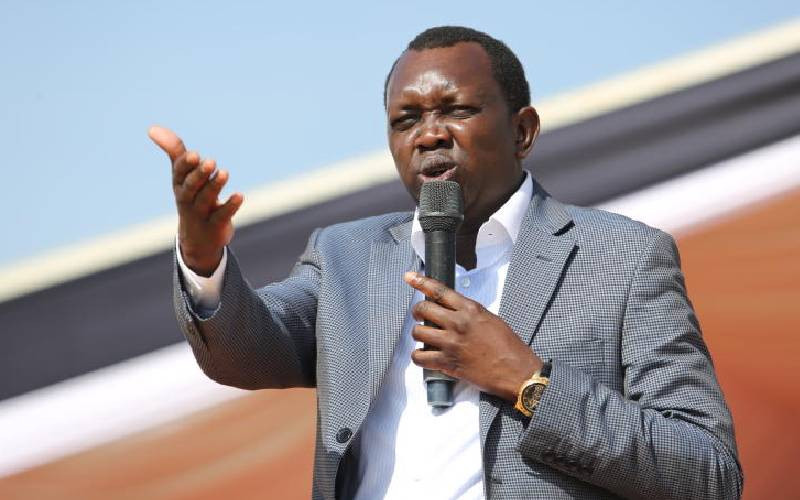Kenya's uptake of debt in the last three years has been alarming, the World Bank has said.
In its latest update on the state of the country’s economy, the global lender said Kenya is about to burst its limits as far as debt sustainability is concerned.
“Although public debt remains sustainable, margins for manoeuvre are rapidly narrowing,” it said in its report, Beyond Resilience: Increasing Productivity of Public Investments.
“With an over 13 percentage point of GDP increase in the debt-to-GDP ratio within a three-year period, and with debt levels over 50 per cent of GDP, and fiscal deficits well above the medium term 4.5 per cent target, the fiscal policy space is fast eroding and margins for further debt accumulation are narrowing,” said the World Bank.
The country’s external debt has increased five-fold, from a record low of Sh361.73 billion in May 2003 to a high of Sh1.8 trillion as at June this year.
Investment projects
Overall debt levels have increased from 42.1 per cent of gross domestic product (GDP), or the value of the goods and services produced by the country in a year, in the 2012-13 financial year to 55.1 per cent of GDP in 2015-16. Total public debt now stands at around Sh3.2 trillion.
The country’s increasing debt levels often touch off acrimonious debate.
Construction of mega infrastructure projects, such as the Sh327 billion standard gauge railway, and major highways, ports and airports, has seen the Government’s expenditure outstrip its revenue, resulting in what is known as a fiscal deficit.
Last week, the International Monetary Fund also raised concern over the Government’s increasing fiscal deficit, which it said is expected to “remain particularly large, and above 7 per cent” on the back of large investment projects.
In the current financial year, the Government projects its Budget deficit to be Sh700 billion, or 9.3 per cent of GDP. It expects to plug this deficit by borrowing Sh459 billion externally and Sh241 billion from the domestic market. The Treasury last week announced plans to float another Eurobond as it moves to finance the Government’s Sh2.3 trillion Budget.
However, the country can take consolation in the fact that debt levels have not gone through the roof.
“Analysis... carried out jointly by the IMF and the World Bank show the risk of distress for the current debt level is still low,” read the World Bank report in part.
Moreover, the country is likely to start reaping the dividends of its infrastructure projects, which should help ease the debt burden.
“These infrastructure expenditures are expected to alleviate binding constraints to the productive capacity of the Kenyan economy, thereby ultimately leading to a decline in debt ratios,” the lender said.
Stay informed. Subscribe to our newsletter
The report also found that the country’s growth trajectory was better than that for sub-Saharan Africa, which has been destabilised by a dip in commodity prices.
However, a limping global economy “could curtail the anticipated strengthening of Kenya’s exports, remittance inflows and tourist receipts”, the bank warned.
Volatile global financial markets may also dampen short-term portfolio outflows, thus undermining macroeconomic stability. And with the country still a target of terrorist attacks, the World Bank flagged “security risks emanating from terrorist activities”, saying these could undermine the recent uptick in tourism.
 The Standard Group Plc is a
multi-media organization with investments in media platforms spanning newspaper
print operations, television, radio broadcasting, digital and online services. The
Standard Group is recognized as a leading multi-media house in Kenya with a key
influence in matters of national and international interest.
The Standard Group Plc is a
multi-media organization with investments in media platforms spanning newspaper
print operations, television, radio broadcasting, digital and online services. The
Standard Group is recognized as a leading multi-media house in Kenya with a key
influence in matters of national and international interest.
 The Standard Group Plc is a
multi-media organization with investments in media platforms spanning newspaper
print operations, television, radio broadcasting, digital and online services. The
Standard Group is recognized as a leading multi-media house in Kenya with a key
influence in matters of national and international interest.
The Standard Group Plc is a
multi-media organization with investments in media platforms spanning newspaper
print operations, television, radio broadcasting, digital and online services. The
Standard Group is recognized as a leading multi-media house in Kenya with a key
influence in matters of national and international interest.








